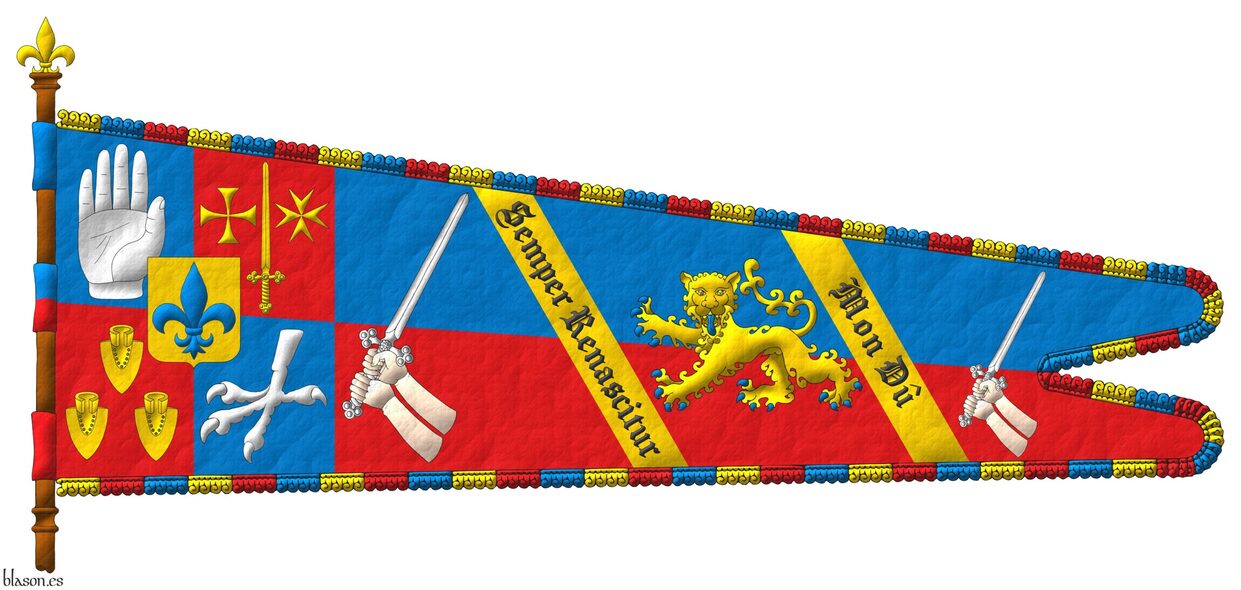Leopard


![Ver [Ailes, A.; 1982] en referencias bibliográficas. Libro abierto, hojas de plata, filo de oro, guardas de gules, tapas de sable.](../css/Libro.Bibliografia.png)
Ailes, A.; 1982
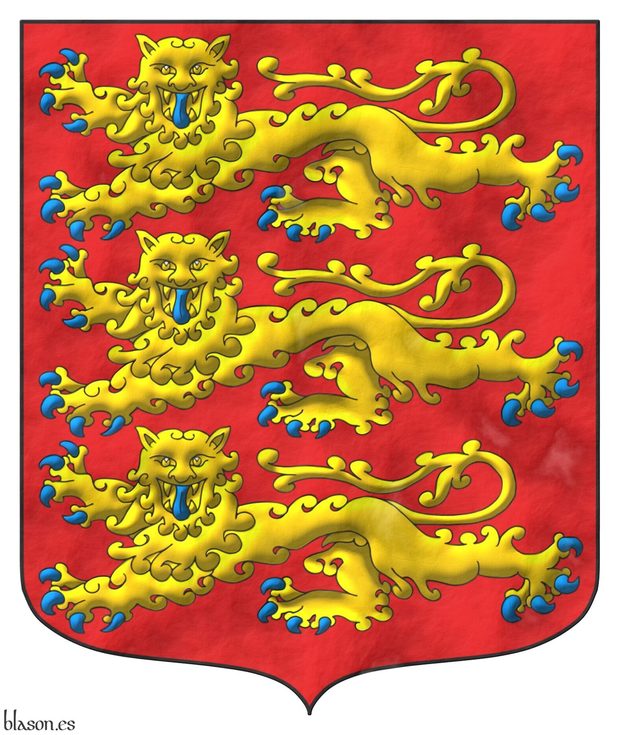
Adrian Ailes, «The Origins of the Royal Arms of England: Their Development to 1199», foreword by Rodney Dennys, includes 27 black and white illustrations, Graduate Centre for Medieval Studies, Reading University, 126 pages, ISBN 07-049077-6-3, Reading, Berkshire, 1982.
An article reviewing this book is: Brigitte Bedos Rezak, Archives nationales de Paris and Metropolitan Museum of Art, «The Origins of the Royal Arms of England, their Development to 1199 by Adrian Ailes», Speculum, volume 60, number 2, pages 373-376, Medieval Academy of America, Cambridge, Massachusetts, April of 1985.
Bibliographical reference of century XX.
The author is Ailes, Adrian.
The following article cites this bibliographic reference:
External resource:


British Monarchy
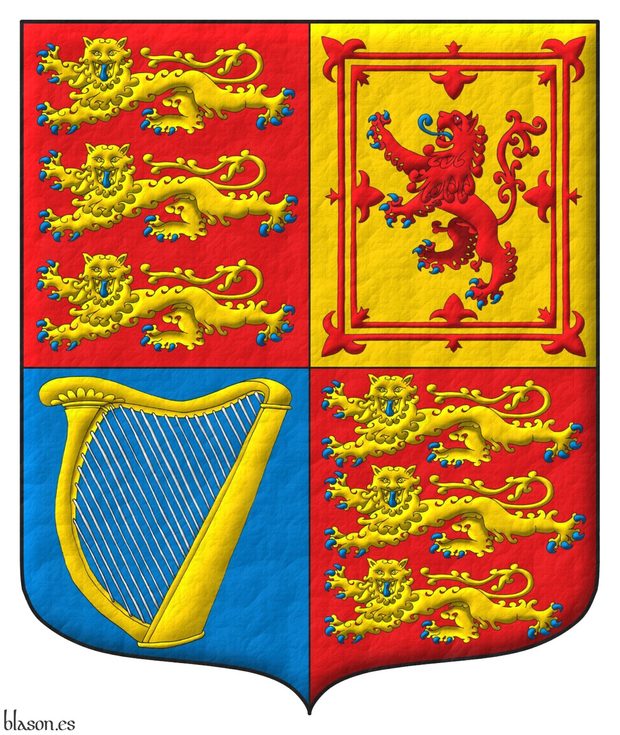
Quarterly: 1 and 4 Gules, three lions passant, guardant, in pale Or, armed and langued Azure; 2 Or, a lion rampant Gules, armed and langued Azure, within a double tressure flory counterflory Gules; 3 Azure, a harp Or, stringed Argent.
Escudo cuartelado: 1o y 4o de gules, tres leopardos en palo de oro, lampasados y armados de azur; 2o de oro, un león de gules, armado y lampasado de azur, encerrado en un trechor doble flordelisado y contraflordelisado de gules; 3o de azur, un arpa de oro cordada de plata.
Arms depicted by me, highlighted with lights and shadows, outlined in Sable, with an ogee external shape and with a leather finish.
These are arms of the British Monarchy emblazoned by me.
Blazon keywords: Gules, Or, Azure, One, Three, Quarterly, Leopard, Pale, Armed, Langued, Lion, Rampant, Double tressure, Flory, Counterflory, Harp and Stringed.
Style keywords: Outlined in sable, Illuminated, Ogee and Leather.
Classification: Civic, Interpreted, Boa and Coat of arms.
Bearer: British Monarchy.


Edmund Plantagenet
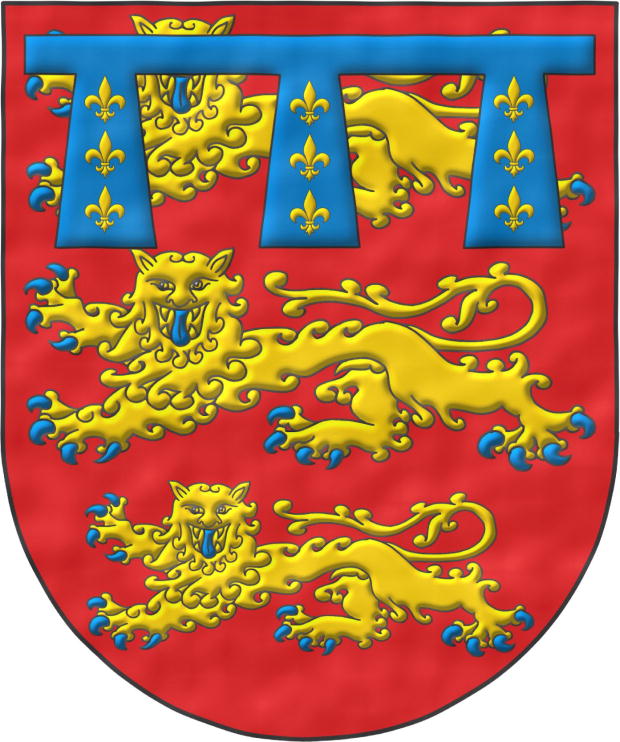
The one with the Cross on his back ~ Crouchback (1245–1296)
Arms of England; overall, a label Azure of three points, each charged with three fleurs-de-lis Or in pale.
Arms interpreted as follows: the mouth of the shield is semicircular (round); the field enamelled in a flat tint of Gules; the label and figures illuminated in Or and Azure and outlined in Sable; and the whole finished with a watercolour effect.
He was the second son of King Henry III of England, and took part in the Ninth Crusade, hence the epithet «Cross on the back».
In 1253 he was appointed Earl of Chester, holding dominion, among others, over the county of Cheshire, but the following year Pope Innocent IV granted him the crown of Sicily, so he ceded his earldom to his elder brother Edward I of England, however, he never came to occupy the throne of Sicily.
The label is an honourable ordinary and also «a kind of mark of cadency, and the most noble of all those used to differentiate the Arms of the younger sons of a House» [Avilés, J.; 1725a; page 248] and it can likewise be used by the eldest son while his father's arms are still in use, ceasing to bear the label when he inherits his father’s coat. When both the eldest and the second son bear a label, the latter’s label then has more points or is charged with figures to distinguish it.
The label is constructed with «a fillet, which is one-ninth of the width of the chief, with three pendants in the form of carpentry wedges or ill-shaped triangles, joined to it without any line of separation, falling twice as far as the fillet is wide, two placed at the ends and one in the middle, its usual position being in the centre of the chief’s length, without reaching the edges of the shield» [Avilés, J.; 1725a; page 248].
Blazon keywords: Without divisions, Gules, Or, Azure, Three, Leopard, Armed, Langued, In pale, Surmounted, Overall (deprecated), Label, Suspended, Charged and Fleur de lis.
Style keywords: Semi-circular, Illuminated, Outlined in sable and Watercolor.
Classification: Interpreted, Personal, Coat of arms, House of Plantagenet and Kingdom of England.
Bearer: Edmund Plantagenet.


Edward I of England

Apodado el Zanquilargo ~ Longshanks.
Gules, three lions, passant, guardant, in pale Or, armed and langued Azure.
Escudo de gules, tres leopardos en palo de oro, armados y lampasados de azur.
Escudo de armas que he interpretado con: la boca de medio punto; el campo esmaltado de tinta plana de color gules; los 3 leopardos iluminados de metal oro, color azur y delineados de sable y el que está en punta es algo menor para adaptarse a la forma del escudo; y el conjunto tiene un acabado rugoso.
Blazon keywords: Without divisions, Gules, Or, Azure, Three, Leopard, Armed, Langued and In pale.
Style keywords: Semi-circular, Illuminated, Outlined in sable and Rough.
Classification: Interpreted, Personal, Coat of arms, House of Plantagenet and Kingdom of England.
Bearer: Edward I of England.


Edward II of England
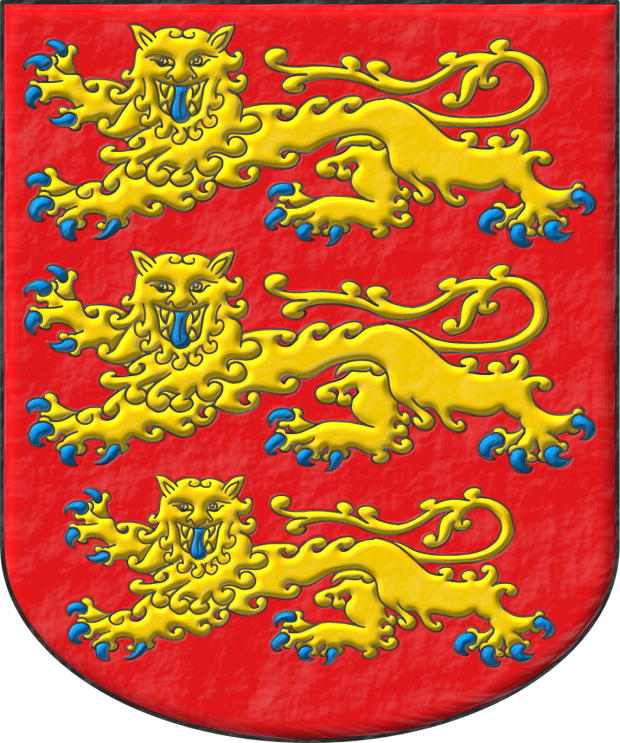
First Prince of Wales from 1301 to 1307, King of England and Lord of Ireland from 1307 to 1327.
Gules, three lions, passant, guardant, in pale Or, armed and langued Azure.
Escudo de gules, tres leopardos en palo de oro, armados y lampasados de azur.
Coat of arms interpreted as follows: the mouth rounded; the field illuminated Gules; the figures illuminated in Or and Azure, outlined in Sable, and the third leopard slightly smaller; and the whole finished with a plastered effect.
Blazon keywords: Without divisions, Gules, Or, Azure, Three, Leopard, Armed, Langued and In pale.
Style keywords: Rounded, Illuminated, Outlined in sable and Gesso.
Classification: Interpreted, Personal, Coat of arms, House of Plantagenet and Kingdom of England.
Bearer: Edward II of England.


Edward IV of England

Banner Quarterly: 1 and 4 Azure, three fleurs de lis Or; 2 and 3 Gules, three lions, passant, guardant, in pale Or, armed and langued Azure.
Pendón cuartelado: 1o y 4o de azur, tres flores de lis de oro; 2o y 3o de gules, tres leopardos en palo de oro, armados y lampasados de azur.
Banner interpreted by me as follows: with the proportions of 5x6, like a shield; the field is coloured in flat tinctures Gules and Azure; the fleurs-de-lis and the leopards are outlined in Sable and illuminated in Or; and the banner’s finish resembles fabric.
Its design follows [Edward IV of England; 1461; row 27, 2nd column, final banner]:
- which represents what are considered «the royal arms of England»,
- which were also borne by Henry V of England,
- which Henry VI of England placed in the 2nd quarter of a per pale shield, where he set those of France in the 1st, and
- which were restored by Henry IV, as shown here.
Blazon keywords: Quarterly, Azure, Or, Three, Fleur de lis, Ordered, Gules, Leopard, Armed, Langued and In pale.
Style keywords: Rectangular, Illuminated, Outlined in sable and Fabric.
Classification: Interpreted, Personal, Flag, Banner of arms, Kingdom of England and House of York.
Bearer: Edward IV of England.


![Ver [Edward IV of England; 1461] en referencias bibliográficas. Libro abierto, hojas de plata, filo de oro, guardas de gules, tapas de sable.](../css/Libro.Bibliografia.png)
Edward IV of England; 1461
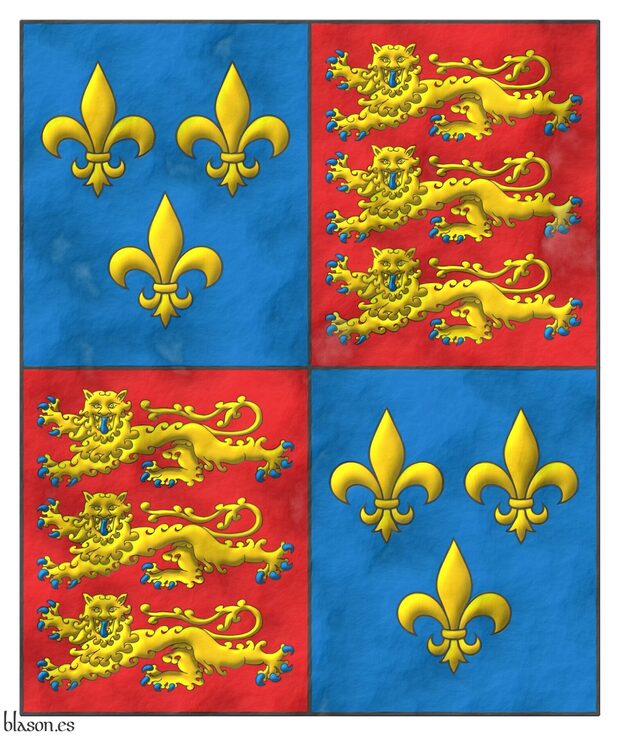
Edward IV King of England and Lord of Ireland, «The Armorial of Edward IV», «The Edward IV Roll», armorial in the form of a roll about 6 meters long, created to celebrate the coronation of Edward IV as the first King of England from the House of York and illustrated, probably, by different artists, 1461.
The image illustrating this reference corresponds to the banner, which is number 27 in the 2nd column, the final one of this armorial. This banner is held by a white deer, which was a personal badge of King Richard II of England, and also, two white deer were the supporters of his shield. The reason for the inclusion of this white deer might be to contribute to the legitimization of Edward IV as king.
It is notable that in row 25 of the 2nd column of this armorial there is a banner with the arms of the shield of Castilla y León, probably because Edward IV, like his predecessors, claimed their throne. In this version of the shield of Castilla y León:
- The two gold castles, in the 1st and 4th quarters of gules, have three towers with the central one taller like the Castilian, but the twin side towers seem to be connected by the wall as in the English castle, [Valero de Bernabé, L.; 2009a; page 2] and [Valero de Bernabé, L.; 2009b; page 33], the wall has a door that is enameled in azure as in the Castilian.
- The two lions, in the 2nd and 3rd quarters of silver, seem to be gold, therefore, of «metal on metal» and, furthermore, very different from the purple lion of Castilla y León, it could well be an error by the artist or a degradation of an original purple enamel to ochre, as explained in the pendón de Castilla y León.
This shield of Castilla y León also appears:
- On the banner in row 27 of the 1st column of this armorial. In this banner, they are combined with the arms of England represented in this article, in a new quartered, under an escutcheon with the imaginary arms of «Brutus of Troy», the also imaginary founder and king of Britain.
- On the caparison of the horse that Edward IV rides in the portrait at the beginning of his armorial. This caparison is a reproduction of the previous banner in row 27 of the 1st column that combined the arms of England with those of Castilla y León. The presence of these arms in this initial portrait of the armorial of Edward IV denotes the importance he gave to his aspirations to the crown of Castilla y León.
Bibliographical reference of century XV.
Author: Edward IV of England.
The following articles cite this bibliographic reference:
- Banner of Castile and León
- Brutus of Britain
- Brutus of Britain, banner
- Charles V of France
- Edward IV of England
- Edward IV, armorial for His coronation
- Edward IV, quartered con Castile and León
- Heraldica Nova
- King Arthur, 3 crowns in pale
- King Arthur, banner with 3 crowns in pale
- King Arthur, banner with cross flory
- King Arthur, cross flory
- Leonor de Aquitania
- Pendón con inescutcheon de Edward IV
External resources:


Elizabeth II of the United Kingdom and the Most Noble Order of the Garter

Quarterly: 1 and 4 Gules, three lions passant, guardant, in pale Or, armed and langued Azure; 2 Or, a lion rampant Gules, armed and langued Azure, within a double tressure flory counterflory Gules; 3 Azure, a harp Or, stringed Argent. Crest: A crown proper. The shield is surrounded by the Most Noble Order of the Garter.
Arms depicted by me, highlighted with lights and shadows, contoured in Sable, with an ogee external shape and with a freehand finish.
Coat of arms of Her Majesty Queen Elizabeth II emblazoned by me. The Most Noble Order of the Garter, founded by Edward III in the 14th century, is Great Britain's oldest and most prestigious order of chivalry. It symbolises honour and loyalty, and its members are chosen by the Sovereign in recognition of their exceptional public service. Its distinctive emblem, a dark blue garter bearing the motto «Honi soit qui mal y pense» ~ «Shame on him who thinks evil of it». Its central insignia features the figure of St George and the Dragon, and its membership is strictly limited to 24 Companion Knights, in addition to the Sovereign and the Prince of Wales.
Blazon keywords: Gules, Or, Azure, One, Three, Quarterly, Leopard, Pale, Armed, Langued, Lion, Rampant, Double tressure, Flory, Counterflory, Harp, Stringed, Saint Eduard crown, Closed royal crown, Crown, Surrounded and Collar.
Style keywords: Outlined in sable, Illuminated, Ogee and Freehand.
Classification: Personal, Interpreted, Boa and Coat of arms.
Bearer: Elizabeth II of the United Kingdom.


England, Kingdom of
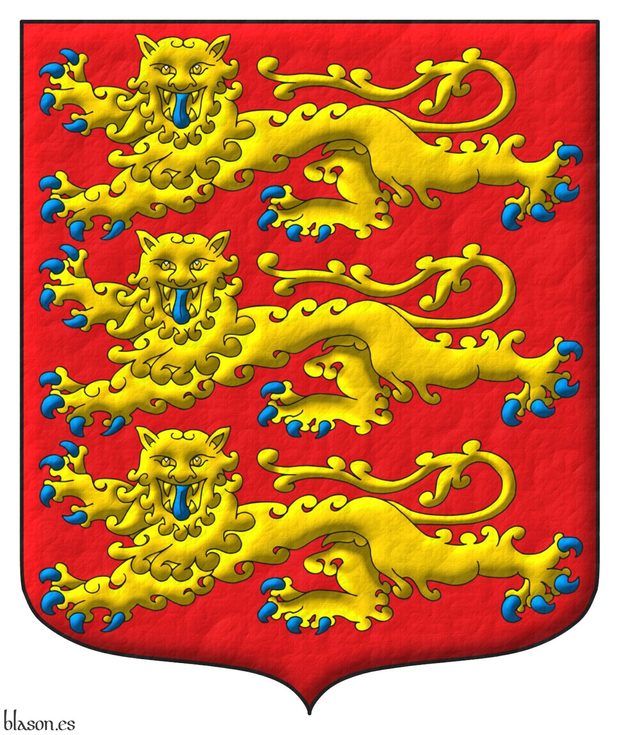
Gules, three lions passant, guardant, in pale Or, armed and langued Azure.
Escudo de gules, tres leopardos en palo de oro, armados y lampasados de azur.
Coat of arms interpreted by me, highlighted with lights and shadows, outlined in Sable, with an ogee external shape and with a leather finishing.
These are arms of the Kingdom of England emblazoned by me.
Blazon keywords: Gules, Or, Azure, Three, Leopard, Pale, Armed and Langued.
Style keywords: Outlined in sable, Illuminated, Ogee and Leather.
Classification: Civic, Interpreted, Boa and Coat of arms.
Bearer: England, Kingdom of.


Henry III of England
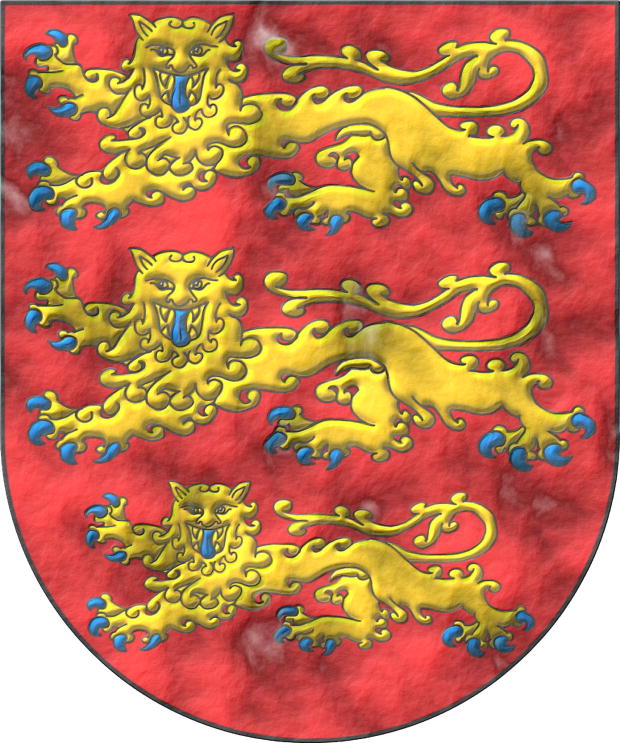
King of England, Lord of Ireland and Duke of Aquitaine from the year 1216 to the year 1272
Gules, three lions, passant, guardant, in pale Or, armed and langued Azure.
Escudo de gules, tres leopardos en palo de oro, armados y lampasados de azur.
Coat of arms interpreted as follows: the mouth of the shield is semicircular (round); its field has been enamelled in a flat tint of Gules; its leopards are illuminated in Or and Azure and outlined in Sable; and the whole has a finish of aged parchment.
Blazon keywords: Without divisions, Gules, Or, Azure, Three, Leopard, Armed, Langued and In pale.
Style keywords: Semi-circular, Illuminated, Outlined in sable and Old parchment.
Classification: Interpreted, Personal, Coat of arms, House of Plantagenet and Kingdom of England.
Bearer: Henry III of England.


![Ver [Humphery-Smith, C.; 1983] en referencias bibliográficas. Libro abierto, hojas de plata, filo de oro, guardas de gules, tapas de sable.](../css/Libro.Bibliografia.png)
Humphery-Smith, C.; 1983
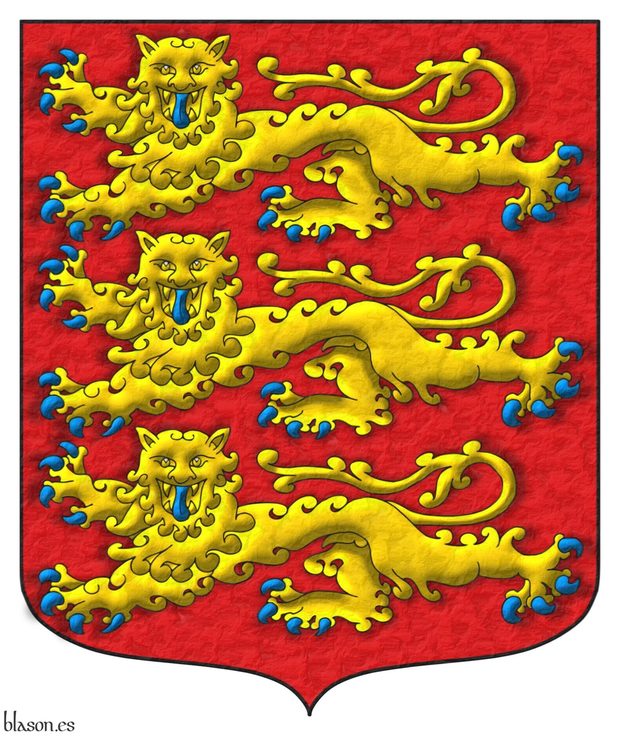
Cecil Humphery-Smith, FHS - Fellow of The Heraldry Society, «Why three Leopards?», Coat of Arms, COA, An Heraldic Quarterly Magazine, issue 126, The Heraldry Society, Baldock, Hertfordshire, summer of 1983.
The coat of arms illustrating this bibliographic reference is that of the Kingdom of England, which was also that of the queen of Castile Leonor Plantagenet.
Bibliographical reference of century XX.
The author is Humphery-Smith, Cecil.
Bibliographic reference mentioned in the following articles:
External link:
Internal resources: HumpherySmithC1983.3Leopards.docx.


John Lackland
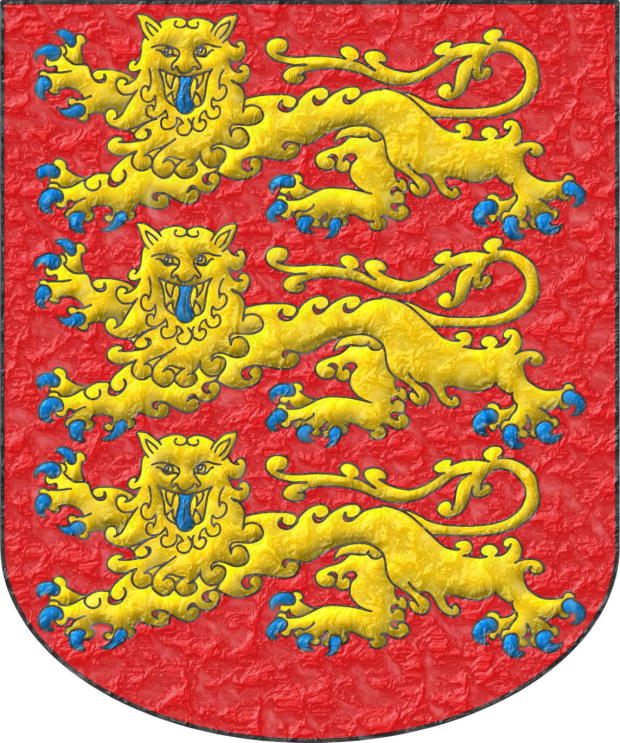
King of England and Lord of Ireland from 1199 to 1216.
Gules, three lions, passant, guardant, in pale Or, armed and langued Azure.
Escudo de gules, tres leopardos en palo de oro, armados y lampasados de azur.
Arms of King John interpreted with: a rounded (semicircular) base; the field enamelled with a flat tint of Gules; the leopards illuminated in Or and Azure, outlined in Sable, all three of the same size; and the whole finished with a crystalline effect.
Blazon keywords: Without divisions, Gules, Or, Azure, Three, Leopard, Armed, Langued and In pale.
Style keywords: Rounded, Illuminated, Outlined in sable and Crystalline.
Classification: Interpreted, Personal, Coat of arms, House of Plantagenet and Kingdom of England.
Bearer: John I of England.


King Charles III Tartan, collage
Quarterly: 1 and 4 Gules, three lions passant, guardant, in pale Or, armed and langued Azure; 2 Or, a lion rampant Gules, armed and langued Azure, within a double tressure flory counterflory Gules; 3 Azure, a harp Or, stringed Argent.
Coat of arms of His Majesty King Charles III emblazoned by me. The background of the shield is the «King Charles III Tartan», combined with two fragments taken from photographs of His Majesty’s kilt: the first placed to the dexter side and below the shield, scaled so that the kilt’s stripes match in size and allow verification of the thread count, sett composition, and physical details confirming the tartan’s vertical alignment; and the second taken from the same photograph of the same kilt but enlarged, where the twill can be seen the bend sinisterwise layout.
Blazon keywords: Gules, Or, Azure, One, Three, Quarterly, Leopard, Pale, Armed, Langued, Lion, Rampant, Double tressure, Flory, Counterflory, Harp and Stringed.
Style keywords: Outlined in sable, Illuminated, Ogee and Metal beaten.
Classification: Personal, Interpreted, Boa, Tartan and Collage.
Bearer: Charles III of the United Kingdom.


Leonor de Aquitania y Enrique de Inglaterra
[ Gules, a lion rampant Or, ] accolé with [ Gules, a lion passant, guardant Or ].
[ Escudo de gules, un león rampante de oro, ] acolado de un [ escudo de gules, un leopardo de oro].
Existing arms interpreted by me as follows: both coat of arms are rotated ±30o; their shapes are pointed; the field of each coat of arms has been enamelled in flat Gules; the lion and the leopard in Or are outlined in Sable; and the whole composition of both arms has a rough texture finish.
Examples of accolated coat of arms (written as «accolé» in the 18th century) can be seen in [Avilés, J.; 1780a; pages 24 and 25 and plate 1: figures 1 and 2].
Blazon keywords: Without divisions, Gules, One, Lion, Or, Rampant and Leopard.
Style keywords: Pointed, Plain tincture, Outlined in sable, Tilted shield and Metal beaten.
Classification: Interpreted, Personal, Accolé arms, Duchy of Aquitaine, Kingdom of France and Kingdom of England.
Bearer: Leonor de Aquitania.


Leonor Plantagenet and Alfonso VIII
[ Gules, a castle triple towered Or, port and windows Azure, masoned Sable ] accolé with [ Gules, three lions, passant, guardant, in pale Or, armed and langued Azure ].
[ Escudo de gules, un castillo de oro, aclarado de azur, mazonado de sable ] acolado de un [ escudo de gules, tres leopardos en palo de oro, armados y lampasados de azur ].
Arms of the King and Queen of Castile interpreted with: the escutcheons' shapes pointed and rounded; the field of each shield, the castle, and the three leopards enamelled in flat tints of Gules and metal Or, with windows, claws, and tongues in Azure; and the whole composition finished with a raised line technique.
[Medél, R.; 1846; page 38] provides a heraldic description of the leopard.
Blazon keywords: Without divisions, Gules, Or, Azure, Three, Leopard, Armed, Langued, In pale, Sable, One, Castle, Port and windows and Masoned.
Style keywords: Ogee, Plain tincture, Outlined in sable, Tilted shield and Freehand.
Classification: Interpreted, Personal, Accolé arms, House of Plantagenet, Kingdom of England and Kingdom of Castile.
Bearer: Leonor Plantagenet.


Marc Eschenlauer
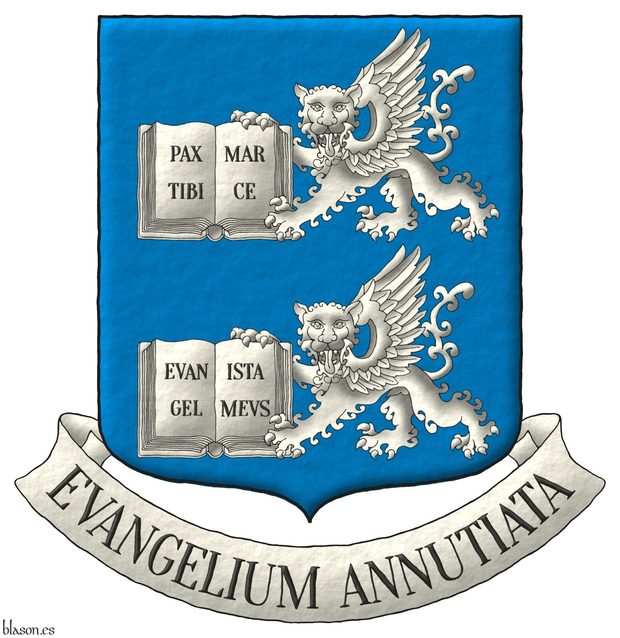
Azure, two lions passant, guardant, winged, each holding in its paws an open book Argent, with the inscription «Pax Tibi Marce Evangelista Meus» Sable distributed on their four pages. Motto: «Evangelium Annutiata».
Escudo de azur, dos leopardos alados, teniendo cada uno en sus garras un libro abierto todo de plata, con la inscripción «Pax Tibi Marce Evangelista Meus» de sable distribuida en sus cuatro páginas. Lema: «Evangelium Annutiata».
Coat of arms designed by me, illuminated with lights and shadows, contoured in Sable, with an ogee outer contour and with a freehand finishing.
Blazon keywords: Azure, Argent, Sable, Two, One, Four, Leopard, Winged, Grasping, Paw, Closed book, Book, Inscribed, Page and Motto.
Style keywords: Outlined in sable, Illuminated, Ogee and Freehand.
Classification: Religious, Created, Boa and Coat of arms.
Bearer: Eschenlauer, Marc.


Normand Delfin, Jacques William

Azure, on three bars wavy Argent, a Norman ship Or, full sail Argent; on a chief Gules, two leopards Or, armed and langued Azure; a bordure Argent charged with eight acorns bendwise Azure.
Escudo de azur, en punta tres burelas ondadas de plata sumadas de un barco normando de oro con vela de plata; en un jefe de gules, dos leopardos de oro, armados y lampasados de azur; una bordura de plata cargada de ocho bellotas puestas en banda de azur.
Arms devised by me, illuminated with lights and shadows, outlined in Sable, with an ogee outer contour and with a watercolor finish.
Coat of arms of Dr. Jacques William Normand Delfin. He is from Mexico and his family comes from Falaise in Normandy. This coat of arms has been created by him and me, and emblazoned by me. The terms «Norman ship» has been chosen instead of other possible names for this type of vessel in order to create a reference to the surname «Normand» of the armiger, whose family descends from Normandy.
Blazon keywords: Azure, Argent, Or, Gules, One, Two, Eight, In base, On, Wavy, Bar, Norman ship, Full sail, Chief, Leopard, Armed, Langued, Bordure, Acorn and Bendwise.
Style keywords: Outlined in sable, Illuminated, Ogee and Watercolor.
Classification: Personal, Created, Boa, Coat of arms and Flag.
Bearer: Normand Delfin, Jacques William.


![Ver [Rabbow, A.; 1999] en referencias bibliográficas. Libro abierto, hojas de plata, filo de oro, guardas de gules, tapas de sable.](../css/Libro.Bibliografia.png)
Rabbow, A.; 1999
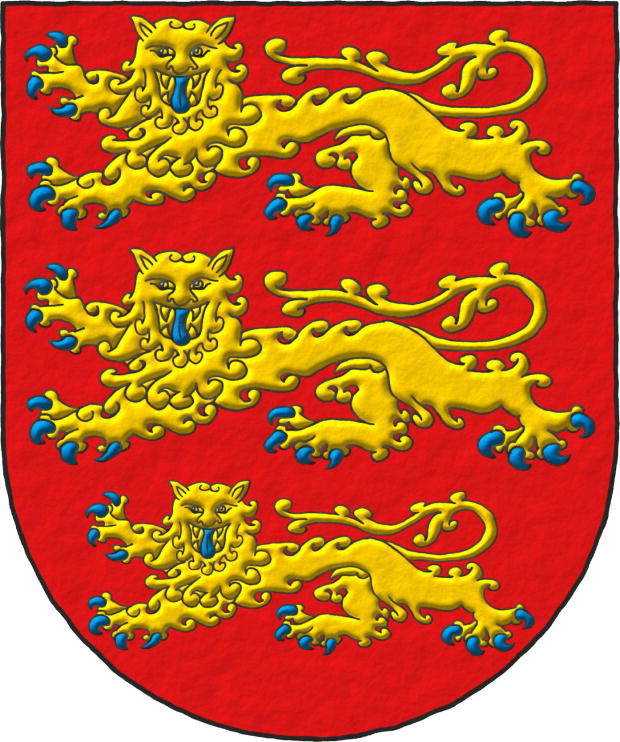
Arnold Rabbow, «The Origin of the Royal Arms of England - a European Connection», Coat of Arms, COA, An Heraldic Quarterly Magazine, número 186, The Heraldry Society, Baldock, Hertfordshire, verano de 1999.
This bibliographical reference is illustrated wit the coat of arms of the Kingdom of England interpreted by me with the with a semi-circle shape.
Bibliographical reference of century XX.
Author: Rabbow, Arnold.
The following article cites this bibliographic reference:
External link:
Internal resources: RabbowA1999.OriginRoyalArmsEnglandEuropeanConnection.docx.


Richard Allen Stowe, crest

Vert, a pall raguly Or between three leopards' faces Or. Crest: Upon a wreath Or and Vert, on a coronet Or a leopard's face Or between two wings Sable.
Escudo de sinople, una perla ecotada de oro entre tres cabezas de leopardo de oro. Timbrado de un burelete de oro y sinople surmontado de una corona de oro surmontada de una cabeza de leopardo de oro acompañada de dos medios vuelos de sable.
Watercolor finishing.
Blazon keywords: Vert, One, Pall, Raguly, Or, Three, Head, Leopard, Crest and mantling, Wreath, Above, Crown, Between, Two, Wing and Sable.
Style keywords: Illuminated, Freehand, Pointed and Outlined in sable.
Classification: Coat of arms, Interpreted and Personal.
Bearer: Stowe, Richard Allen.


Rudolph Andries Ulrich Juchter van Bergen Quast, crown and mantle
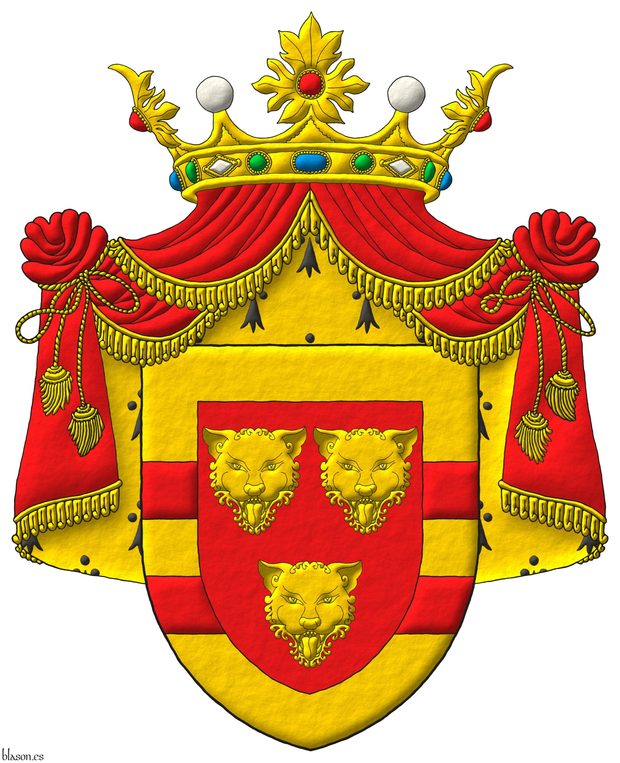
Gules, three Leopards faces Or, the whole within a Border Or with two Bars Gules. Crest: A crest coronet proper. Mantle: Gules doubled Erminois.
Freehand finishing
Blazon keywords: Gules, Three, Head, Leopard, Or, Ordered, Bordure, Two, Bar, Crest and mantling, Crown of Prince, Crown, Open, Mantle, Erminois and Sable.
Style keywords: Freehand, Pointed, Illuminated and Outlined in sable.
Classification: Coat of arms, Interpreted and Personal.
Bearer: Juchter van Bergen Quast, Rudolph Andries Ulrich.


Standard of Laurent Liu-Lecomble
Heraldic device designed by me, illuminated with lights and shadows, outlined in Sable, and with a leather finish.
This is the heraldic standard of Laurent Liu-Lecomble, designed by him and me, and emblazoned by me. Structure: coat of arms; from his badge, the two arms bendwise proper, grasping a sword bend sinisterwise; motto «Semper renascitur»; a leopard Or, armed and langued Azure; warcry «Mon dû»; from his badge, the two arms bendwise grasping a sword bend sinisterwise.
Blazon keywords: Azure, Argent, Gules, Or, One, Two, Three, Quarterly, Dexter, Hand, Appaumée, Sword, Point upwards, Between, Cross patty, Cross couped, Sinister, Eight-pointed cross, Plough share, Affronty, Disordered, Eagle claw, Inescutcheon, Charged, Fleur de lis, Arm, Bendwise, Proper, Grasping, Bend sinisterwise, Motto, Leopard, Passant, Armed, Langued and War cry.
Style keywords: Outlined in sable, Illuminated and Leather.
Classification: Personal, Created, Boa, Standard and Flag.
Bearer: Liu-Lecomble, Laurent.


The Heraldry Society, motto
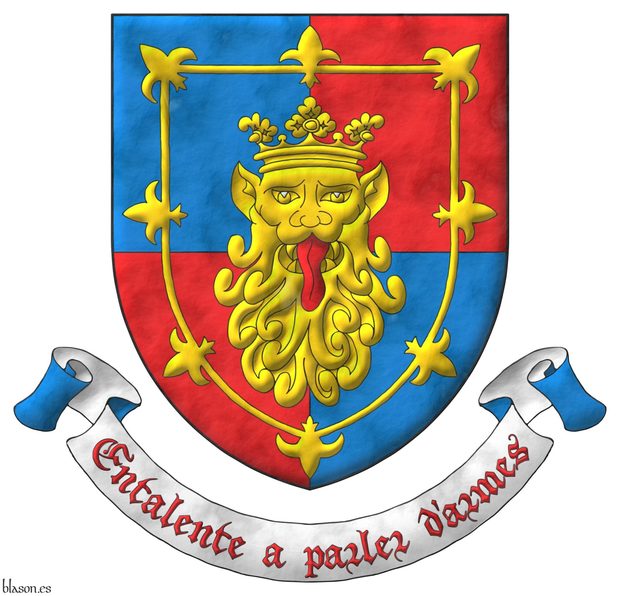
Quarterly Azure and Gules; overall a leopard face, crowned Or, langued Gules, within a tressure flory Or. Motto: «Entalente a parler d'armes».
Escudo cuartelado de azur y gules; brochante sobre el todo, una cabeza de leopardo coronada de oro, lampasada de gules, dentro de un trechor flordelisado de oro. Lema: «Entalente a parler d'armes».
The official blazon of this coat of arms is «Quarterly Azure and Gules a lion’s face crowned with an Ancient Crown Or within a tressure flory on the outer edge of the same». The following are my comments to the official blazon:
- With «crowned» can be assumed the common default «crowned with an ancient crown».
- With «tressure flory» can be assumed the common default «tressure flory on the outer edge».
- I use to specify the «langued», for example Gules or Azure, because I think there is not a common default tincture for «langued» in all heraldic traditions.
- The use of «overall» can help to understand the blazon, then I add it.
Blazon keywords: Quarterly, Azure, Gules, Overall, Head, Leopard, Crowned, Or, Langued, Within, Tressure, Flory and Motto.
Style keywords: Pointed, Illuminated, Outlined in sable, Shaded and Freehand.
Classification: Interpreted, Socioeconomic and Coat of arms.
Bearer: The Heraldry Society.


![Ver [The Heraldry Society; 2013] en referencias bibliográficas. Libro abierto, hojas de plata, filo de oro, guardas de gules, tapas de sable.](../css/Libro.Bibliografia.png)
The Heraldry Society; 2013
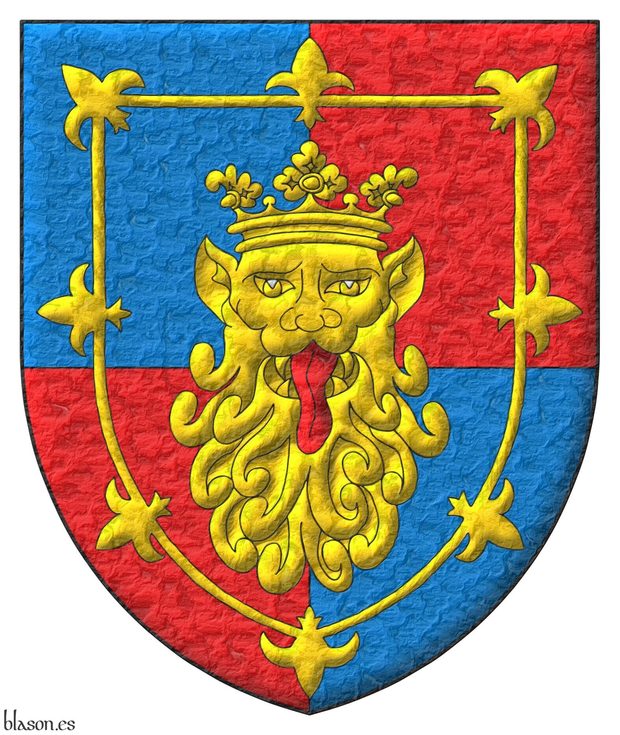
The Heraldry Society, «Education Pack, A brief explanation of Heraldry for teachers together with explanatory sheets and templates for students», Baldock, Hertfordshire, 2013.
This bibliographical reference is illustrated with the quartered coat of arms of The Heraldry Society.
Bibliographical reference of century XXI.
Author: The Heraldry Society.
Bibliographic reference mentioned in the following articles:
- Balaguer, municipality of
- Chequey, chequy or checky
- Drawing the arcs of a pointed coat of arms
- Geoffrey Plantagenet
- Savoy, Duchy of
External resource:
Internal resources: TheHeraldrySociety2013.EducationPack.pdf.
-
Language
-
Categories of heraldry
-
Divisions of the field
- Without divisions
- Party per pale
- Party per fess
- Party per bend
- Party per bend sinister
- Tierce
- Tierce sinister
- Tierced per pale
- Tierced per fess
- Tierced per bend
- Tierced pallwise inverted
- Quarterly
- Quarterly per saltire
- Gyronny
- Party per fess, the chief per pale
- Party per pale, the sinister per fess
- Party per fess, the base per pale
- Party per pale, the dexter per fess
- Chapé
- Chaussé
- Embrassé
- Contre-embrassé
- Party per chevron
- Enté
- Enté en point
- Flanched
-
Metals
-
Colours
-
Furs
-
Other tinctures
-
Ordinaries and sub-ordinaries
-
Diminutives of the ordinaries
-
Geometric charges
-
Composite ordinaries
-
Inanimate charges from Nature
Atom, Crescent, Diamond, Emerald, Estoile, Increscent, Lightning flash, Moon, Mount, Mullet, Mullet of four points, Orbital, Plough of Ursa Major, Rainbow, Ray of the sun, River, Sea, Snowflake, Sun, Sun in splendour, Sun of May, Trimount, Water and Wave.
-
Vegetal charges from Nature
Acorn, Apple, Apple tree, Ash, Bluebonnet, Camellia, Chrysanthemum, Cinquefoil, Cornflower, Dogwood flower, Double rose, Elm, Fleur de lis, Flower, Gourd, Holm oak, Hop cone, Indian paintbrush, Kapok tree, Laurel, Lily, Linden, Lotus flower, Madonna lily, Mexican cedar tree, Oak, Olive tree, Palm tree, Plantain plant, Pomegranate, Poplar leaf, Rose, Shamrock, Sunflower, Thistle, Tree, Tulip, Vine and Wheat.
-
Animal charges from Nature
Badger, Bald eagle, Barbel, Barn owl, Bear, Beaver, Bee, Beetle, Bighorn sheep, Binson, Blackbird, Boar, Brach hound, Bull, Doe, Dog, Dolphin, Dove, Eagle, Elephant, Falcon, Female figure, Fish, Flame, Fly, Fox, Frog, Goat, Goldfinch, Goose, Heron, Horse, Hummingbird, Jaguar, Lark, Leopard, Lion, Lion passant, Lion rampant guardant, Lioness, Lynx, Male figure, Martlet, Merino ram, Owl, Panther, Parrot, Peacock, Pelican, Pelican in her piety, Pronghorn, Puffin, Quetzal, Raven, Roe deer, Rooster, Savage, Seagull, Serpent, She-wolf, Stag, Starling, Talbot, Turtle, Tyger, Vulture, Warren hound and Wolf.
-
Parts of natural charges
Arm, Beak, Branch, Caboshed, Chest, Claw, Covert, Dorsal fin, Eagle claw, Ermine spot, Escallop, Feather, Foot (palmiped), Foreleg, Forepaw, Hand, Head, Heart, Hoof, Leaf, Neck, Ostrich feather, Palm frond, Paw, Roe deers' attires, Shoulder, Sprig, Stags' attires, Stem, Swallow-tail, Tail, Tail addorsed, Tail fin, Talon, Tibia, Tooth, Trunk, Trunk (elephant), Two hands clasped, Two wings in vol, Udder, Wheat spike, Wing and Wrist.
-
Artificial charges
Ace of spades, Anchor, Anvil, Arch, Arm vambraced, Armillary sphere, Arrow, Axe, Bell, Bell tower, Beret, Bonfire, Book, Bookmark, Bow, Branding iron, Bridge, Broken, Buckle, Cannon, Cannon dismounted, Cannon port, Canopy roof, Carbuncle, Castle, Celtic Trinity knot, Chain, Chess rooks, Church, Clarion, Clay pot, Closed book, Club, Column, Comb, Compass rose, Conductor's baton, Cord, Covered cup, Crozier, Crucible, Cuffed, Cup, Cyclamor, Dagger, Double vajra, Drum, Ecclesiastical cap, Fanon, Federschwert, Fleam, Four crescents joined millsailwise, Galician granary, Garb, Gauntlet, Geometric solid, Grenade, Halberd, Hammer, Harp, Host, Hourglass, Key, Key ward, Knight, Knot, Lantern, Letter, Line, Loincloth, Menorah, Millrind, Millstone, Millwheel, Monstrance, Mortar, Mullet of six points pierced, Nail, Non-classic artifact, Norman ship, Number, Oar, Oil lamp, Open book, Page, Pair of scales, Parchment, Pestle, Piano, Pilgrim's staff, Plough share, Polish winged hussar, Port, Portcullis, Potent, Quill, Ribbon, Rosette of acanthus leaves, Sabre, Sackbut, Sail, Scroll, Scythe, Sheaf of tobacco, Ship, Skirt, Spear, Spear's head, Stairway, Star of David, Step, Sword, Symbol, Tetrahedron, Torch, Tower, Trident, Trumpet, Turret, Two-handed sword, Wagon-wheel, Water-bouget, Wheel, Winnowing fan and With a turret.
-
Immaterial charges
Angel, Archangel, Basilisk, Dragon, Dragon's head, Garuda, Golden fleece, Griffin, Heart enflamed, Justice, Mermaid, Our Lady of Mercy, Ouroboros, Paschal lamb, Pegasus, Phoenix, Sacred Heart of Jesus, Saint George, Sea-griffin, Trinity, Triton, Unicorn, Winged hand and Wyvern.
-
External elements
-
Heraldic creations
-
References
-
Formats
-
Keywords on this page
Between, Watercolor, Pointed, Armed, Harp, Azure, Flag, Bibliography, Boa, Bordure, Surmounted, Bar, Head, House of Plantagenet, Ogee, Counterflory, Stringed, Crown, Created, Quarterly, Outlined in sable, Two, In pale, Coat of arms, Fleur de lis, Flory, Personal, Gules, Illuminated, Interpreted, Langued, Motto, Leopard, Lion, Semi-circular, Ordered, Or, Pale, Leather, Argent, Without divisions, Rampant, Kingdom of England, Sable, Century XX, Freehand, Double tressure, Three and One.

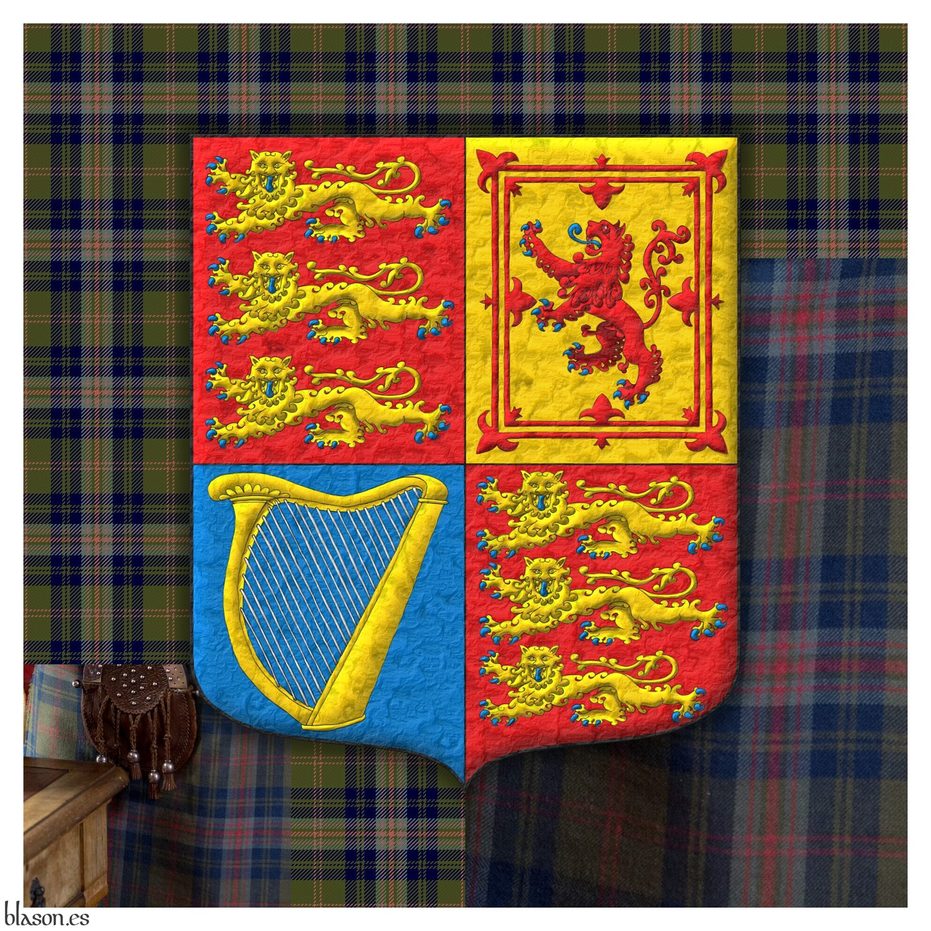
![Leonor de Aquitania y Enrique de Inglaterra [ Gules, a lion rampant Or, ] accolé with [ Gules, a lion passant, guardant Or ].](../escudo_armas/LeonorA.22.EnriqueII.jpg)
![Leonor Plantagenet and Alfonso VIII [ Gules, a castle triple towered Or, port and windows Azure, masoned Sable ] accolé with [ Gules, three lions, passant, guardant, in pale Or, armed and langued Azure ].](../escudo_armas/LeonorP.23.Matrimonio.jpg)
